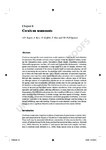Corals on seamounts
| dc.contributor.author | Rogers, AD | |
| dc.contributor.author | Baco, A | |
| dc.contributor.author | Griffiths, H | |
| dc.contributor.author | Hall-Spencer, Jason | |
| dc.contributor.editor | Pitcher TJ | |
| dc.contributor.editor | Hart PJB | |
| dc.contributor.editor | Morato T | |
| dc.contributor.editor | Santos R | |
| dc.contributor.editor | Clark M | |
| dc.date.accessioned | 2013-02-20T19:52:28Z | |
| dc.date.available | 2013-02-20T19:52:28Z | |
| dc.date.issued | 2007-01-01 | |
| dc.identifier.isbn | 9781405133432 | |
| dc.identifier.uri | http://hdl.handle.net/10026.1/1388 | |
| dc.description.abstract |
Corals are amongst the most conspicuous sessile organisms found on the hard substrates of seamounts. They include a diverse array of groups within the phylum Cnidaria, including the Scleractinia (stony corals), Antipatharia (black corals), Zoanthidea (zoanthids), Octocorallia (gorgonians, sea fans, soft corals) and Stylasteridae (hydrocorals). Estimating global coral diversity on seamounts is complicated by a lack of samples. However, they are an important component of the species diversity found on seamounts, playing a pivotal role in structuring the environment. In particular, some scleractinian corals have the ability to form cold-water reefs that may have a diverse community of associated organisms. Gorgonian corals may form dense stands that also play a structural role in communities of fish and other organisms. Corals found on seamounts show a diverse range of life histories although patterns of recruitment to populations are not understood. Isotopic methods for ageing corals have revealed that individual colonies may be slow growing and can live for hundreds to thousands of years. The distribution of corals on seamounts depends on a variety of physical and biological factors. Relative distribution of the coral groups differs regionally and between oceans, reflecting differences in ocean chemistry, productivity and biogeography. The different coral groups also show significant differences in depth of occurrence resulting from differences in trophic ecology and other aspects of biology. Because of their fragility, conservative life histories and limited geographic distribution, cold-water corals are vulnerable to the impacts of human exploitation through coral harvesting or as bycatch of fishing, especially trawling. Changes in ocean chemistry resulting from climate change are also a significant threat to corals on seamounts and other marine habitats. | |
| dc.format.extent | 141-169 | |
| dc.language.iso | en | |
| dc.publisher | Blackwell Scientific | |
| dc.relation.ispartof | Seamounts: Ecology Fisheries and Conservation, Blackwell Fisheries and Aquatic resources Series | |
| dc.title | Corals on seamounts | |
| dc.type | chapter | |
| plymouth.publication-status | Published | |
| dc.identifier.doi | 10.1002/9780470691953.ch8 | |
| plymouth.organisational-group | /Plymouth | |
| plymouth.organisational-group | /Plymouth/Faculty of Science and Engineering | |
| plymouth.organisational-group | /Plymouth/Faculty of Science and Engineering/School of Biological and Marine Sciences | |
| plymouth.organisational-group | /Plymouth/PRIMaRE Publications | |
| plymouth.organisational-group | /Plymouth/REF 2021 Researchers by UoA | |
| plymouth.organisational-group | /Plymouth/REF 2021 Researchers by UoA/UoA07 Earth Systems and Environmental Sciences | |
| plymouth.organisational-group | /Plymouth/Research Groups | |
| plymouth.organisational-group | /Plymouth/Research Groups/Marine Institute | |
| plymouth.organisational-group | /Plymouth/Users by role | |
| plymouth.organisational-group | /Plymouth/Users by role/Academics | |
| dc.rights.embargoperiod | Not known | |
| rioxxterms.versionofrecord | 10.1002/9780470691953.ch8 | |
| rioxxterms.licenseref.uri | http://www.rioxx.net/licenses/all-rights-reserved | |
| rioxxterms.type | Book chapter |


